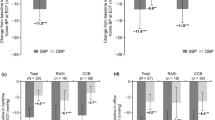Summary
Nanterinone (UK-61,260) is a novel positive inotropic and balanced-type vasodilating drug, only partially based on phosphodiesterase III inhibition. Preliminary data from controlled studies suggest satisfactory long-term efficacy and safety. As its acute hemodynamic effects in humans are unknown, an oral dose of 2 mg nanterinone was studied in 14 patients with heart failure (NYHA class II-III) on chronic diuretic and angiotensin-converting enzyme (ACE) inhibitor treatment. Before the study, patients were on a 2 g saltbalanced diet, and they received their last medication 16 hours before each study day. Hemodynamic measurements were carried out before and 0.5, 1, 1.5, 2, 2.5, 3, 4, 8, 12, and 24 hours after administration of the study drug. All patients received placebo and nanterinone on 2 consecutive days. Following nanterinone, systemic vascular resistance decreased immediately from 1699±82 (mean±SEM) at baseline to 1368±80 at 1 hour. Changes persisted for 12 hours. Concomitantly, there was an immediate and significant fall in pulmonary wedge pressure to 38% of baseline at 1.5 hours, together with a 20% reduction in pulmonary artery pressure. Heart rate remained unchanged and arterial pressures showed only a short, significant decrease. Cardiac index rose significantly from 2.28±0.15 at baseline to a highest value of 2.65±0.14 1/min/m2 at 1 hour. Changes persisted for 3 hours. Placebo had no effct on these variables. As, in view of its potential venodilating properties, hemodynamic improvement by nanterinone may depend on pre-existing left ventricular filling pressure, patients were subsequently grouped according to baseline pulmonary wedge pressure of>12 mmHg (H-PCWP) and ≤12 mmHg (L-PCWP). Cardiac index improved by 26% in H-PCWP and by 17% in L-PCWP (NS). In contrast, PCWP fell more markedly in H-PWCP than in L-PCWP (40% and 23%, respectively, p<0.05). Thus, oral nanterinone results in a significant acute hemodynamic improvement and is well tolerated. Although changes in left ventricular filling pressure are more pronounced in patients with elevated preexisting PCWP, cardiac pump function improves equally in patients with normal or low left ventricular filling pressure at baseline.
Similar content being viewed by others
References
Remme WJ. Inodilator therapy for heart failure. Early, late or not at all?Circulation 1993;87(Suppl IV):IV97-IV107.
Alabaster CT, Bell AS, Campbell SF, et al. 2(1H)-Quinolinones with cardiac stimulant activity. 2. Synthesis and biological activities of 6-(N-linked, five-membered heteroaryl) derivatives.J Med Chem 1989;32:575–583.
Ellis P, Henderson CG, Kidd TL, Samuels GMR. Beneficial haemodynamic profile of UK-61,260 in an anaesthetised dog heart failure model (abstr).Br J Pharmacol 1988;95:695P.
Schwinger RHG, La Rosée K, Mittmann C, Böhm M. The effects of UK-61,260 on force of contraction in human myocardium (abstr).Circulation 1990;82:III729.
Remme WJ, Boström P-A, Westheim A, Hayden M, Collier J the European UK-61,260 Study Group. Contrasting efficacy and safety of low versus high degree of phosphodiesterase inhibition in mild heart failure (abstr).J Am Coll Cardiol 1992;19:260A.
Ellis P, Henderson CG, Samuels GMR. UK-61,260: A novel cardiac stimulant and vasodilator agent.Br J Pharmacol 1987;91:392P.
Orchard C, Than N, Alabaster C. The effect of the inotropic agent UK-61,260 on calcium transients in ferret heart (abstr).J Mol Cell Cardiol 1992;24(Suppl 1):S84.
Remme WJ, Van Hoogenhuyze DCA, Krauss XH, Kruijssen HACM, Pieper PG, Bruggeling WAJ. Preload-dependent hemodynamic effects of milrinone in moderate heart failure.Cardiology 1992;80:132–142.
Benotti JR, Grossman W, Braunwald E, Davolos DD, Alousi AA. Hemodynamic assessment of amrinone: A new inotropic agent.N Engl J Med 1978;299:1373–1377.
Wynne J, Malacoff RF, Benotti JR, et al. Oral amrinone in refractory congestive heart failure.Am J Cardiol 1980;45: 1245–1249.
Maskin CS, Sinoway L, Chadwick B, Sonnenblick EH, Le Jemtel TH. Sustained hemodynamic and clinical effects of a new cardiotonic agent, WIN 47203, in patients with severe congestive heart failure.Circulation 1983;67:1065–1070.
Jaski BE, Fifer MA, Wright RF, Braunwald E, Colucci WS. Positive inotropic and vasodilator actions of milrinone in patients with severe congestive heart failure.J Clin Invest 1985;75:643–649.
Uretsky BF, Generalovich T, Reddy PS, SPangenberg RB, Follansbee WP. The acute hemodynamic effects of a new agent, MDL 17,043, in the treatment of congestive heart failure.Circulation 1983;67:823–828.
Kereiakes D, Chatterjee K, Parmley WW, et al. Intravenous and oral MDL 17043 (a new inotrope-vasodilator agent) in congestive heart failure: Hemodynamic and clinical evaluation in 38 patients.J Am Coll Cardiol 1984;4: 884–889.
Opie LH. Inodilators.Lancet 1986;1:336.
Colucci WS, Deniss AR, Leatherman GF, et al. Intracoronary infusion of dobutamine to patients with and without severe congestive heart failure. Dose-response relationships, correlation with circulating catecholamines and effect of phosphodiesterase inhibition.J Clin Invest 1988;81: 1103–1110.
Borow KM, Come PC, Neumann A, Baim DS, Braunwald E, Grossman W. Physiologic assessment of the inotropic, vasodilator and afterload reducing effects of milrinone in subjects without cardiac disease.Am J Cardiol 1985;55: 1204–1209.
Remme WJ, Kruijssen HACM, Gehlmann H, Meuret G. Preload-dependent hemodynamic improvement by the Ca2+-sensitizer isomazole in moderate heart failure (abstr).Eur Heart J 1992;13:168.
DiBianco R. Clinical results with oral milrinone in heart failure.Eur Heart J 1989;10(Suppl C):44–52.
Smyth P, Timmis A, Kerkez S, Jewitt DE. Stimulatory effects of milrinone on plasma renin angiotensin system and the response to orthostatic tilt.Circulation 1986;74(Suppl II):II-311.
Author information
Authors and Affiliations
Rights and permissions
About this article
Cite this article
Remme, W.J., van der Ent, M., Bartels, G.L. et al. Acute hemodynamic effects and preload-dependent cardiovascular profile of the partial phosphodiesterase inhibitor nanterinone in patients with mild to moderate heart failure. Cardiovasc Drug Ther 10, 137–144 (1996). https://doi.org/10.1007/BF00823591
Received:
Accepted:
Issue Date:
DOI: https://doi.org/10.1007/BF00823591




